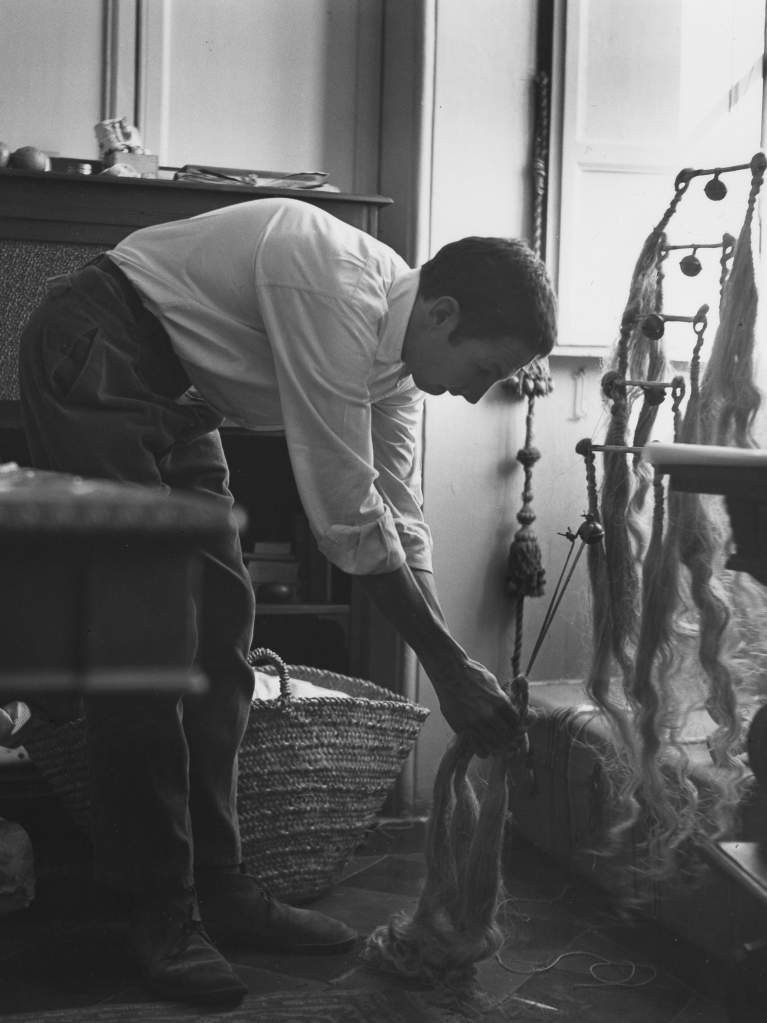1950-59
1952
January: For the Museum of Modern Art, New York, Edward Steichen acquires two photographs made by Rauschenberg at Black Mountain College, near Asheville, North Carolina: Untitled (Interior of an Old Carriage) (1949) and Untitled (Cy on Bench) (1951); these works are the first acquired by a museum.
Spring–summer: Continues at Black Mountain College, studying with visiting faculty Jack Tworkov and Franz Kline. Also studies with John Cage and Merce Cunningham, collaborators since 1942, who allow movement and music to coexist without any predetermined relationship except for that of time. Rauschenberg’s friendship with Cage and Cunningham solidifies over the course of the summer, and their collaborations will manifest and develop for the remainder of their lives.
Spring break: Travels with Cy Twombly to Charleston, South Carolina; New Orleans; Key West; and Cuba. While in Cuba, Rauschenberg experiments with transfer drawing, rubbing the back of a printed image to transfer images to another sheet of paper, a technique he will fully develop in 1958.
Summer: Participates in an untitled event (later referred to as Theater Piece No. 1, now considered the first Happening) organized by Cage, in the dining hall of Black Mountain College. Varying accounts of the unscripted event describe activities occurring simultaneously: Cunningham improvises a dance around and through the audience, Cage delivers a lecture, M. C. Richards recites poetry from a ladder, David Tudor plays piano, and Rauschenberg plays old records by Edith Piaf and others on a hand-wound, Edison, horn record player. Charles Olson also participates, most likely reading his own poetry. Slides and a flickering eight-millimeter film, possibly by Nick (Nicola) Cernovich, may have been projected onto the walls and ceiling. Panels of Rauschenberg’s White Paintings are hung from the rafters overhead. Other participants include R. Buckminster Fuller and Dorothea Rockburne.8
August: Cage creates his silent piece 4'33", a work in three movements in which Tudor, seated quietly at a piano, signals the beginning and end of each movement by opening and closing the keyboard cover. Cage acknowledges that Rauschenberg’s White Paintings, as well as a visit to Harvard University’s anechoic chamber—a soundproof and reverberation-free environment—inspired the work.
August 10: The exhibition Paintings by Robert Rauschenberg opens at Black Mountain College. 9
August 20: Sets sail for Naples, Italy aboard the SS Argentina, scheduled to arrive on September 1, stopping in the Sicilian port of Palermo on the way. Travels with Twombly, who has won a travel fellowship from the Virginia Museum of Fine Arts, Richmond. Rauschenberg had photographed Twombly’s paintings for the application portfolio.
September: Rauschenberg and Twombly settle in Rome, near Piazza di Spagna.
September 1952–February 1953: Takes numerous photographs and accumulates a collection of objects from which he creates three significant groups of work: (1) A series of collages, referred to as North African Collages (1952), fabricated on cardboard from laundered shirts using local printed papers and old engravings found in bookstalls and flea markets.10 (2) Feticci Personali, hanging “fetish” assemblages of wood, rope, animal fur, and various small objects, which may be inspired by ritual artifacts used by North African tribes that he sees during his travels. These works are Rauschenberg’s first to involve suspension; although none are known to be extant, several are documented in photographs by the artist in Rome (ca. 1953) and in the Fulton Street studio (ca. 1954). (3) Scatole Personali (1952–53), wood or metal boxes containing found objects and materials such as pebbles, sticks, dirt, engravings, and beads. These three groups reveal the influence of Joseph Cornell with whom Rauschenberg was familiar through exhibitions at Egan Gallery, New York (for example, a December 1949 exhibition from which Susan Weil’s parents bought three of Cornell’s works) and having visited Cornell’s home on Utopia Parkway, Queens, New York, to transport works to the Egan Gallery.
October: Rauschenberg and Weil’s divorce is finalized.
Late October: Out of money, the artist travels to North Africa and gets a job with the Atlas Construction Company in Casablanca. Twombly joins him later in the year, and the two travel through Morocco to Tangier, where they meet writer Paul Bowles, a friend of Cage, with whom they travel to Tétouan in northern Morocco.
- 8. For additional accounts of the event, see Duberman, Black Mountain, pp. 350–58, and William Fetterman, “The Untitled Event at Black Mountain College, Theatre Piece, Solos in Song Books, and Dialogue: Variations on Small-Group Simultaneities,” in John Cage’s Theatre Pieces: Notations and Performances (Amsterdam: Harwood Academic Publishers, 1996).
- 9. No information other than the printed announcement survives.
- 10. Of these intimately scaled collages, thirty-eight are known to still exist. In 1990, Rauschenberg created Shirtboards, an editioned version of these collages.

 Robert Rauschenberg, Bob + Cy, Venice, 1952
Robert Rauschenberg, Bob + Cy, Venice, 1952


 Rauschenberg working on Feticci Personali series (1952–53), Rome, 1953. Photo: Attributed to Cy Twombly
Rauschenberg working on Feticci Personali series (1952–53), Rome, 1953. Photo: Attributed to Cy Twombly
